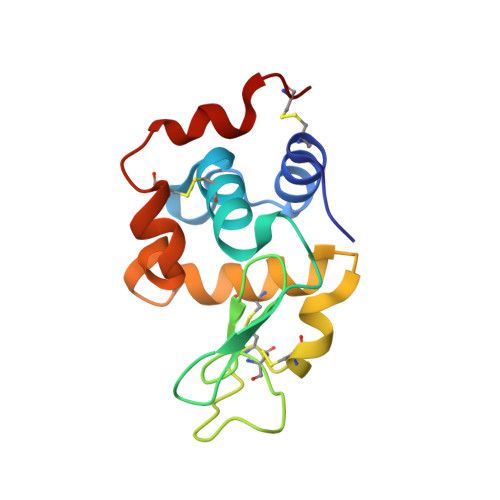A novel transition-state analogue for lysozyme, 4-O-beta-tri-N-acetylchitotriosyl moranoline, provided evidence supporting the covalent glycosyl-enzyme intermediate.
Ogata, M., Umemoto, N., Ohnuma, T., Numata, T., Suzuki, A., Usui, T., Fukamizo, T.(2013) J Biological Chem 288: 6072-6082
- PubMed: 23303182
- DOI: https://doi.org/10.1074/jbc.M112.439281
- Primary Citation of Related Structures:
4HP0, 4HPI - PubMed Abstract:
4-O-β-Di-N-acetylchitobiosyl moranoline (2) and 4-O-β-tri-N-acetylchitotriosyl moranoline (3) were produced by lysozyme-mediated transglycosylation from the substrates tetra-N-acetylchitotetraose, (GlcNAc)4, and moranoline, and the binding modes of 2 and 3 to hen egg white lysozyme (HEWL) was examined by inhibition kinetics, isothermal titration calorimetry (ITC), and x-ray crystallography. Compounds 2 and 3 specifically bound to HEWL, acting as competitive inhibitors with Ki values of 2.01 × 10(-5) and 1.84 × 10(-6) m, respectively. From ITC analysis, the binding of 3 was found to be driven by favorable enthalpy change (ΔHr°), which is similar to those obtained for 2 and (GlcNAc)4. However, the entropy loss (-TΔSr°) for the binding of 3 was smaller than those of 2 and (GlcNAc)4. Thus the binding of 3 was found to be more favorable than those of the others. Judging from the Kd value of 3 (760 nm), the compound appears to have the highest affinity among the lysozyme inhibitors identified to date. X-ray crystal structure of HEWL in a complex with 3 showed that compound 3 binds to subsites -4 to -1 and the moranoline moiety adopts an undistorted (4)C1 chair conformation almost overlapping with the -1 sugar covalently bound to Asp-52 of HEWL (Vocadlo, Davies, G. J., Laine, R., and Withers, S. G. (2001) Nature 412, 835-838). From these results, we concluded that compound 3 serves as a transition-state analogue for lysozyme providing additional evidence supporting the covalent glycosyl-enzyme intermediate in the catalytic reaction.
- Department of Bioscience, Graduate School of Science and Technology, Shizuoka University, Shizuoka 422-8529, Japan.
Organizational Affiliation:

















